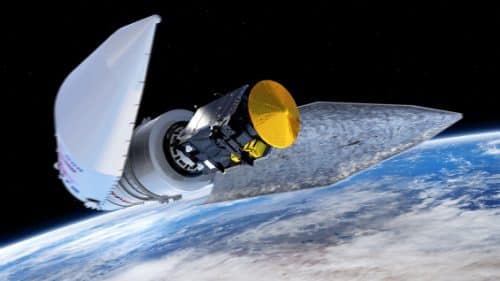The first mission of the ExoMars program is expected to reach Mars later in 2016, and consists of a compass that will measure the traces of rare gases in the atmosphere as well as a module that will demonstrate new lowering and landing methods called Schiaparelli

The first mission of the ExoMars program is expected to reach Mars later in 2016, and it consists of a compass that will measure the traces of rare gases in the atmosphere as well as a module that will demonstrate new lowering and landing methods called Schiaparelli. The main goals of the mission are to look for evidence of methane and other trace elements that may indicate biological or geological processes and to test new technologies for future ESA missions to Mars.
The rover and the lander will be launched together tomorrow, March 14, and will remain attached for the entire trip to Mars, which will last seven months, so that the pair of spacecraft will reach the red planet in October. Three days before their arrival in the Martian atmosphere, the Schiaparelli lander will be released from the orbit towards Mars. Schiaparelli will enter the atmosphere at a speed of 21 km/h using air arresters and a parachute, and then it will brake with the help of an engine system before landing on the Martian soil. From takeoff to landing, Schiafferly will keep in touch with the Mekapet. When it reaches the ground, it will be able to communicate with the Earth also through the Mars Express spacecraft as well as through the American spacecraft.
The ExoMars rover will enter a circular orbit, approximately 400 kilometers high, so that it can carry out its scientific mission. The spacecraft was designed by the European Space Agency, while the Russian space agency Roscosmos is responsible for the launchers. The mekpet's warehouse contains instruments designed to facilitate the scientific mission. The spacecraft will make detailed observations from space of the Martian atmosphere and look for evidence of biologically important gases such as methane and its derivatives.
Various instruments are also installed on board the Mikapet that will perform many measurements to locate the location and nature of the source of these gases. The scientific mission is expected to begin in December 2017 and last five years. The ExoMars rover will also serve as a relay station for the all-terrain vehicle that will be launched by the European Space Agency in 2018, until the ExoMars program ends in 2022.
Schiaparelli, the lander that will travel together with ExoMars to Mars will be a demonstration spacecraft that will provide the European Space Agency with the technology needed to land on Mars at a controlled speed. The European Space Agency says that Schiaparelli's design maximizes the use of technologies that have already been developed as part of the ExoMars program, including special materials for thermal protection, a parachute system, a radar for measuring height and a final brake system controlled by liquid fuel.
The lander will operate on the surface of Mars for several days, until its batteries are depleted.

One response
The measuring instruments on the spacecraft have 3 cryogenic refrigerators made by the Recor factory in Ein Harod Ihud